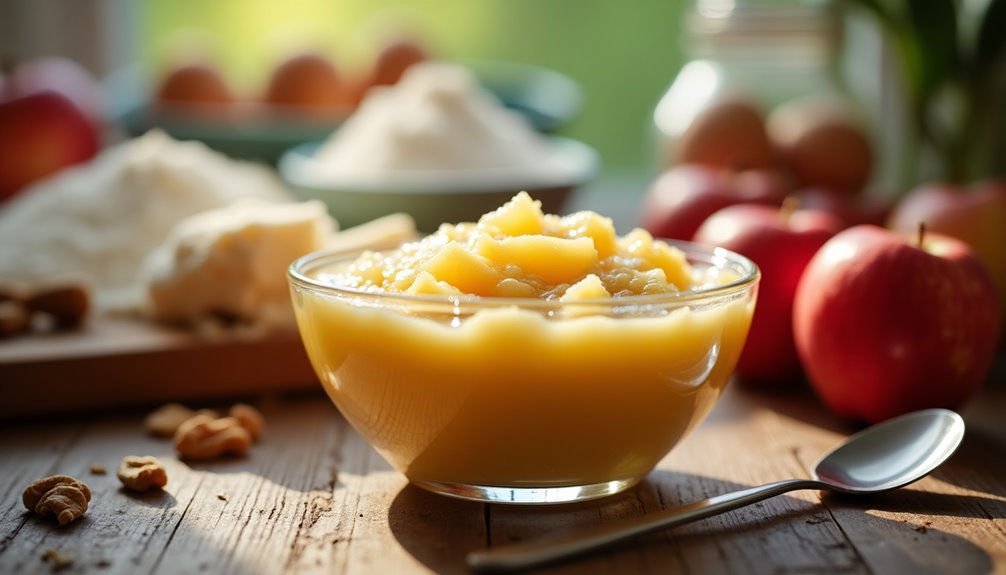Substituting applesauce for oil in baking is a smart choice that enhances flavor while cutting down on calories. Simply replace oil with an equal amount of unsweetened applesauce. This swap retains moisture and creates a softer texture in your baked goods, but it may slightly change the flavor and consistency. You might need to adjust sugar levels and liquids in your recipe due to the added sweetness of applesauce. Experimenting with different varieties can also yield unique flavors. With a few adjustments, you can create delicious treats, and there's much more to uncover about successful baking techniques.
Key Takeaways
- Substitute an equal amount of unsweetened applesauce for oil to enhance moisture and reduce calories in baked goods.
- Adjust sugar and liquid levels in the recipe, as applesauce adds natural sweetness and moisture.
- Be mindful of the flavor profile; different types of applesauce can impact the taste of your baked goods.
- Monitor baking time and temperature closely, as substituting applesauce may require slight adjustments for optimal results.
- Combine applesauce with other substitutes like yogurt or mashed bananas for improved texture and flavor in recipes.
Benefits of Using Applesauce
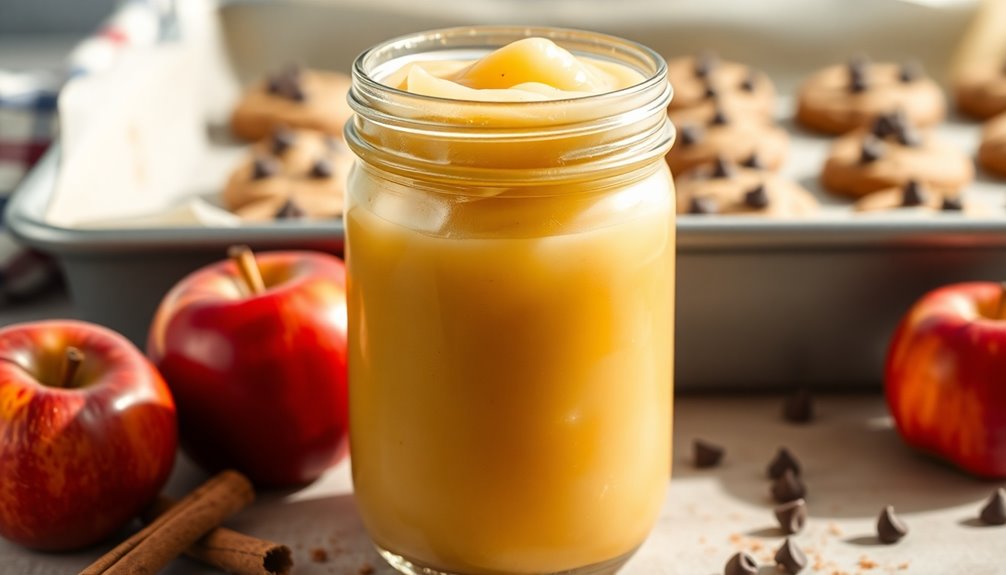
When you substitute applesauce for oil in baking, you reveal several remarkable benefits that can enhance your recipes. One of the key advantages is flavor enhancement. Applesauce adds a subtle sweetness and a hint of fruity flavor, which can elevate the overall taste of your baked goods. This natural sweetness allows you to reduce added sugars, contributing to a healthier recipe without sacrificing flavor.
You'll find that cookies, cakes, and muffins take on a delightful depth when you incorporate this simple ingredient.
Another significant benefit of using applesauce is moisture retention. Oil typically provides fat that keeps baked goods tender, but applesauce excels at retaining moisture, keeping your treats soft and delicious. This is particularly important for recipes like brownies or quick breads, where a dry texture can be disappointing.
By using applesauce, you guarantee that your baked items remain moist for longer, enhancing the eating experience.
Moreover, the use of applesauce can create a more cohesive batter, making it easier to work with. This can foster a sense of connection as you share your baking endeavors with friends and family. By incorporating this ingredient, you're not just making a healthier choice; you're also embracing a more inviting approach to baking.
In a world where connection through food is cherished, using applesauce can help you create treats that not only taste great but also bring people together.
How to Substitute Applesauce
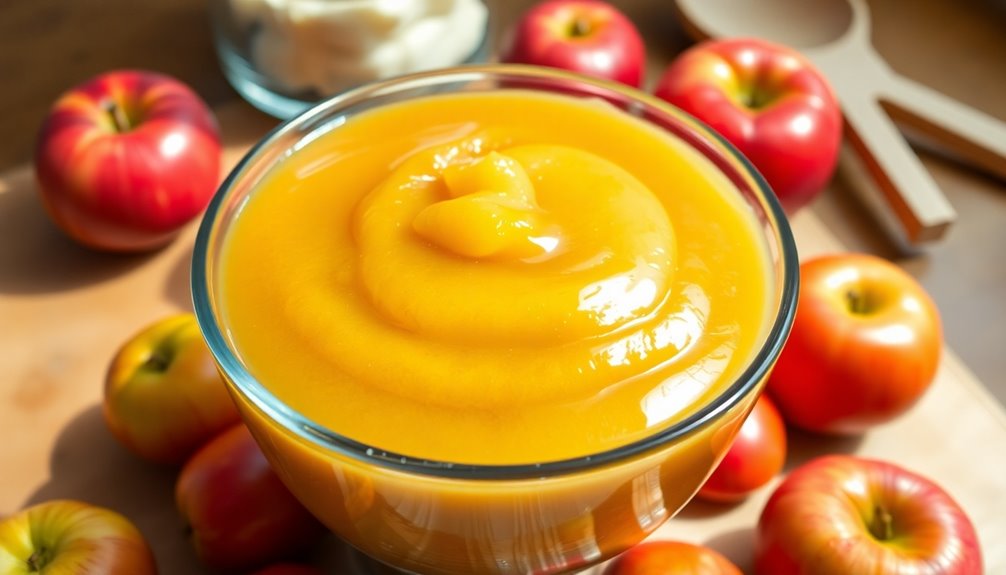
Substituting applesauce for oil in your baking recipes is a straightforward process that can yield delicious results. To get started, you'll want to use an equal amount of unsweetened applesauce in place of the oil called for in your recipe. This means if your recipe asks for 1 cup of oil, simply use 1 cup of applesauce. This swap not only reduces fat but also enhances the moisture and applesauce texture in your baked goods.
However, keep in mind that this substitution can slightly alter the flavor impact of your dish. While applesauce adds a subtle sweetness and fruity note, it might not be suitable for every recipe. Consider the overall taste you want to achieve and adjust other ingredients accordingly.
Here's a quick reference table to guide you in this substitution:
| Oil Type | Applesauce Replacement | Texture Change | Flavor Impact |
|---|---|---|---|
| Vegetable Oil | 1:1 | Moist and soft | Mild sweetness |
| Olive Oil | 1:1 | Denser, more cake-like | Fruity undertones |
| Coconut Oil | 1:1 | Chewy, rich | Coconut flavor |
| Butter | 1:1 | Tender | Sweet, buttery notes |
Best Recipes for Applesauce Baking
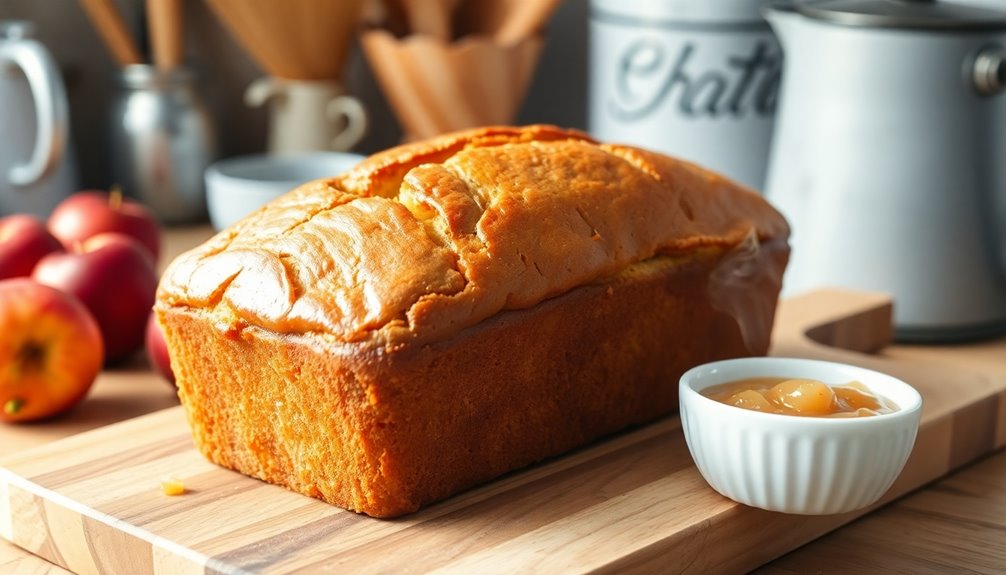
Many bakers have discovered the benefits of using applesauce in their recipes, and it's no wonder why. Incorporating applesauce not only reduces fat but also enhances flavor combinations and provides texture improvements that can elevate your baked goods. If you're excited to try out some fantastic recipes that feature this versatile ingredient, consider these four delightful options:
- Applesauce Banana Bread: Blend ripe bananas with applesauce for a moist and flavorful loaf. The combination creates a rich texture and complements the natural sweetness of the bananas.
- Spiced Applesauce Muffins: Infuse your muffins with warm spices like cinnamon and nutmeg. The applesauce adds moisture and a tender crumb, making these muffins a perfect breakfast or snack.
- Chocolate Applesauce Cake: This rich cake uses unsweetened applesauce to replace oil, resulting in a fudgy texture. Pair it with chocolate chips for an indulgent treat that feels decadent without the added calories.
- Applesauce Oatmeal Cookies: Combine oats and applesauce to create chewy cookies with a wholesome touch. You can add raisins or nuts for extra flavor combinations, ensuring each bite is satisfying.
These recipes not only showcase the versatility of applesauce but also invite you to explore new textures and flavors in your baking. By experimenting with these ideas, you'll find a community of bakers who share the joy of creating delicious and healthier treats.
Tips for Successful Baking
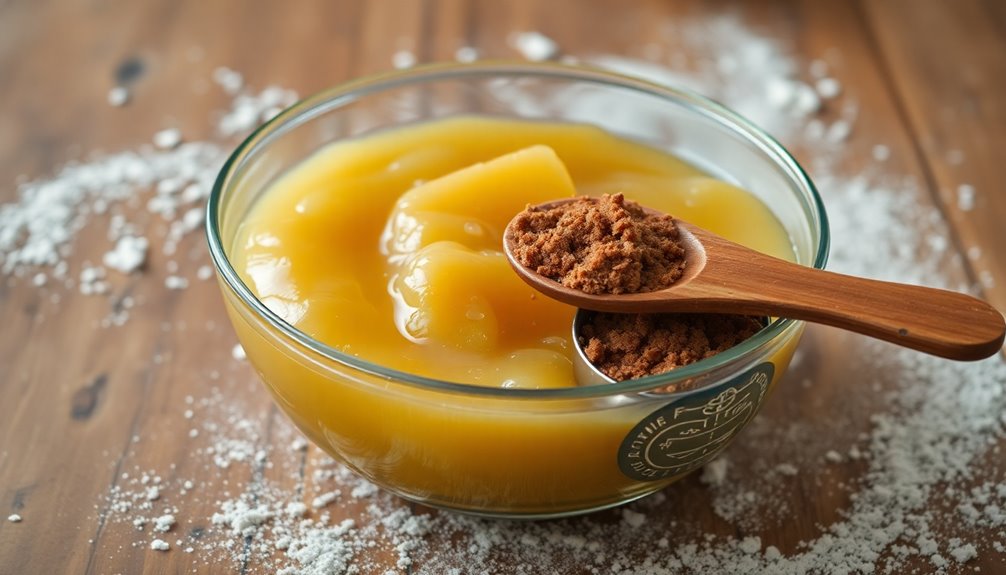
Successful baking hinges on understanding both the ingredients and techniques involved in the process. To achieve the best results, you need to pay attention to a few key tips that can elevate your baking game.
First, familiarize yourself with different baking techniques. Whether it's folding, creaming, or whisking, mastering these methods guarantees that your ingredients blend harmoniously, leading to the desired texture and rise.
Next, consider how flavor combinations can enhance your baked goods. Experimenting with various spices, fruits, or extracts can transform a basic recipe into something extraordinary. For instance, pairing cinnamon with applesauce adds warmth and depth, while incorporating vanilla can bring out the sweetness of your dish. Don't hesitate to mix and match flavors that resonate with your palate.
Another essential tip is to measure your ingredients accurately. Baking is a science, and small deviations can lead to significant differences in outcome. Use a kitchen scale for precise measurements, especially when working with flour or sugar.
Lastly, always preheat your oven. This simple step guarantees that your baked goods cook evenly and rise properly.
Nutritional Comparison: Applesauce vs. Oil
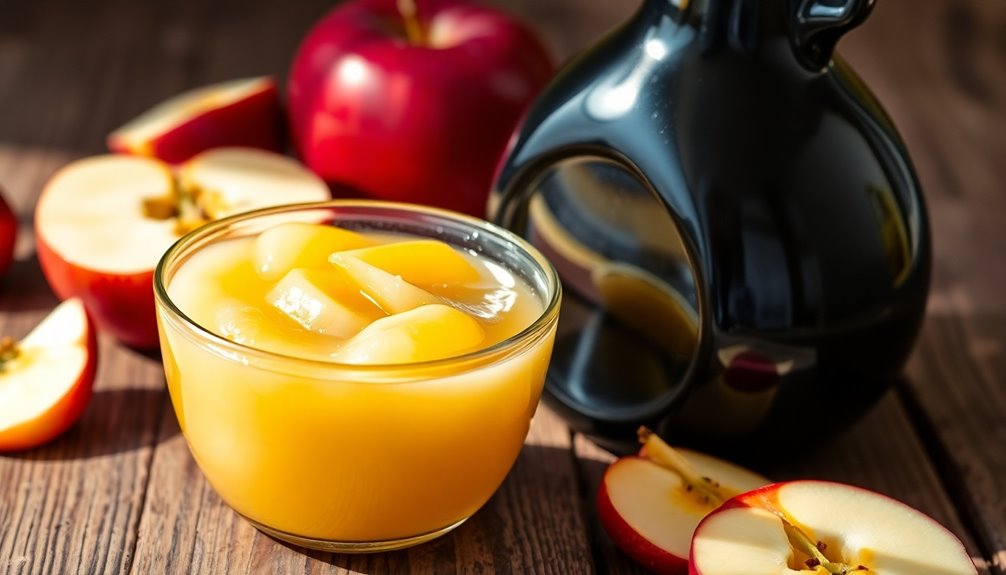
When you weigh the nutritional differences between applesauce and oil, it becomes clear that each ingredient brings unique benefits to your baking. Here's a breakdown of how they compare nutritionally and how these differences can impact your recipes:
- Calories: Applesauce is lower in calories than most oils, making it a great choice for those looking to reduce calorie intake. For example, a cup of applesauce has around 100 calories, while a cup of vegetable oil contains approximately 1,900 calories.
- Fat Content: Oils are high in fat, particularly healthy fats like omega-3s and omega-6s, which can be beneficial in moderation. In contrast, applesauce contains virtually no fat, making it heart-healthier.
- Vitamins and Minerals: Applesauce provides vitamins like vitamin C and potassium, which oils lack. This can enhance the nutritional profile of your baked goods, giving you a boost of essential nutrients.
- Flavor Comparison & Texture Differences: When it comes to flavor, oil can add richness and depth, while applesauce lends a subtle sweetness and fruitiness to your recipes.
Texture-wise, using applesauce can result in a moister final product, which is particularly desirable in cakes and muffins, while oil contributes a tender crumb.
Common Mistakes to Avoid
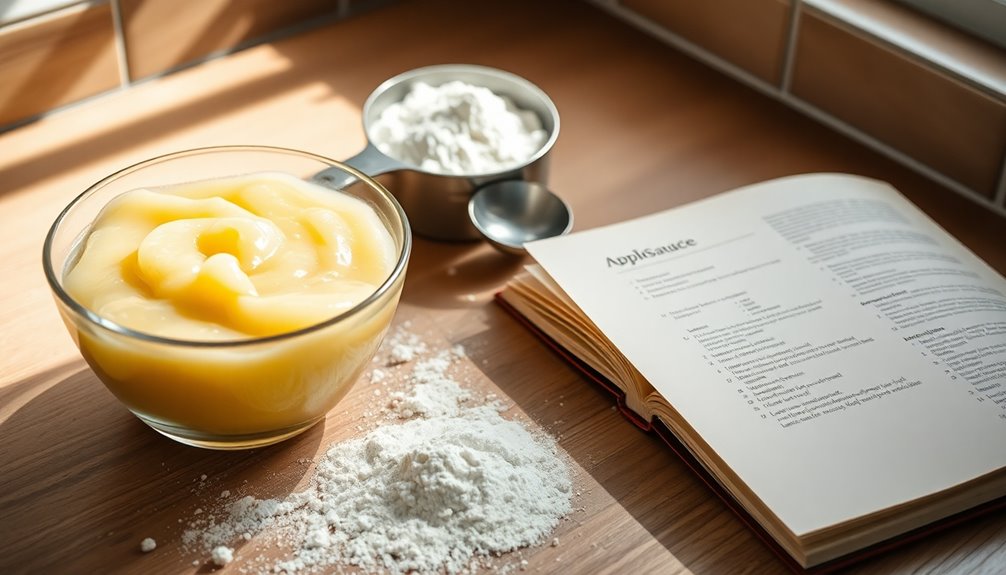
Baking with applesauce instead of oil can lead to delicious results, but there are common mistakes that can undermine your efforts. One of the most essential aspects in this substitution is proper measurement. It's easy to assume you can swap applesauce for oil in a one-to-one ratio, but this isn't always the best approach. Applesauce contains more water than oil, which can alter the moisture levels in your baked goods. Depending on the recipe, you might need to adjust the quantity to maintain the right balance.
Another mistake is neglecting the texture impact. While applesauce can make your treats moist and tender, using too much can result in a gummy or overly dense outcome. Pay attention to the original recipe's texture; if it's meant to be light and fluffy, take into account reducing the amount of applesauce slightly or incorporating additional dry ingredients to compensate.
Also, don't forget about the flavor. Applesauce brings its own sweetness and fruitiness that may not suit every recipe. If you're baking something that relies on a neutral flavor, like a savory bread, you might want to contemplate using unsweetened applesauce or pairing it with spices to balance the taste.
Frequently Asked Questions
Can I Use Homemade Applesauce for Baking Instead of Store-Bought?
Absolutely, you can use homemade applesauce for baking! Just make sure your applesauce consistency matches that of store-bought varieties, as this can impact your baking results. Homemade applesauce might be chunkier or thinner, which could change texture and moisture levels in your recipes.
If you've balanced the ingredients correctly, your baked goods will probably turn out delicious and flavorful, highlighting your personal touch. Enjoy the process and the unique taste of your homemade creation!
Does the Type of Oil Affect the Applesauce Substitution?
Think of oil as the quiet conductor in your baking symphony; its consistency can dramatically alter the harmony of your dish. Yes, the type of oil does impact your applesauce substitution. Different oils have varying consistencies, which can lead to distinct baking results.
For instance, a thick oil might yield a denser texture, while a lighter oil can create a fluffier outcome. Understanding these nuances guarantees your baked goods resonate with the right flavor and texture.
How Does Applesauce Affect the Texture of Baked Goods?
When you use applesauce in your baking, it notably affects the texture of your goods. It enhances moisture retention, making your treats softer and less dry. You'll notice a texture improvement, especially in cakes and muffins.
However, be aware that it might also cause a taste alteration, adding a subtle sweetness. These changes can lead to delightful baking results, creating a final product that feels inviting and satisfying for everyone who enjoys your creations.
Can I Use Flavored Applesauce in Baking Recipes?
Yes, you can use flavored applesauce in baking recipes. The flavor impact can enhance your treats, adding a unique twist that regular applesauce mightn't provide. However, be mindful that the baking results may vary based on the flavor you choose; for instance, cinnamon or pumpkin spice could complement certain recipes beautifully, while others may clash.
Experimenting with flavored applesauce can lead to delightful discoveries, making your baked goods stand out in taste and aroma.
Is There a Limit to How Much Applesauce I Can Substitute?
When considering substitution limits for ingredients in baking, it's essential to understand how changes affect baking results.
You can usually replace oil with applesauce in a 1:1 ratio, but using too much can alter texture and moisture. Generally, aim for a maximum of ¾ cup of applesauce for every cup of oil.
Experiment, but keep in mind that excessive substitution may lead to denser or overly moist baked goods, affecting overall quality.
Conclusion
Incorporating applesauce as a substitute for oil in baking not only enhances flavor but also promotes a healthier treat. By understanding how to effectively replace oil with applesauce, you're opening the door to deliciously moist baked goods. Remember, the key lies in balance—achieving the right consistency while embracing the natural sweetness of applesauce. So, why not give it a try? Your taste buds and waistline might just thank you for the delightful change!

